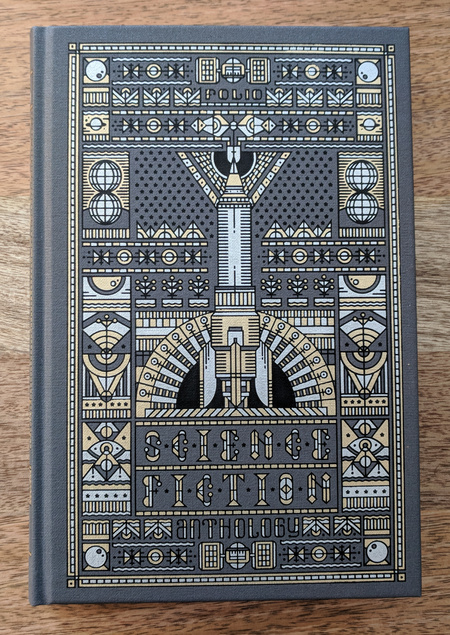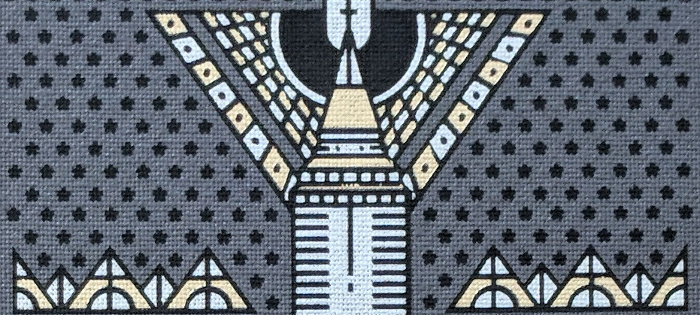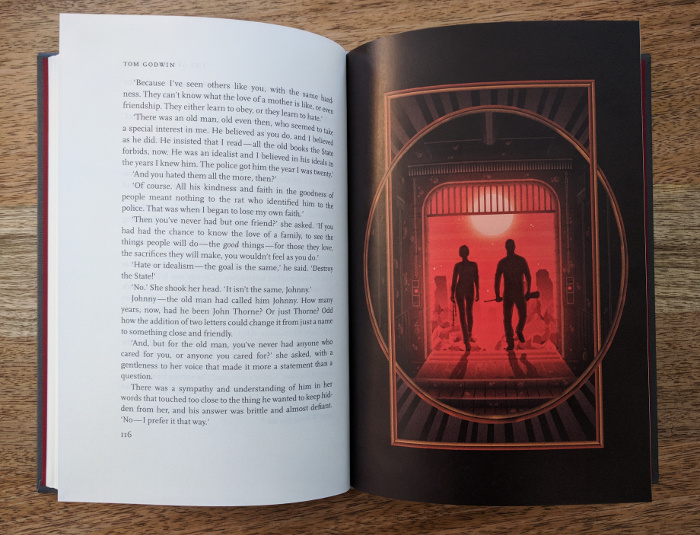Review: The Folio Society Science Fiction Anthology
Many sci-fi readers will recognize the name Brian Aldiss (1925–2017), both from his own stories and novels, and from the many anthologies he compiled. The first, for Penguin Science Fiction, was published in 1961. This one is the last, and it is also Aldiss’ final published work. It was published by the Folio Society, which specializes in expensive but beautiful editions of many classic and contemporary works, and which also publishes original anthologies such as this one.
The packaging
You won’t find this book on Amazon, and it is currently advertised at USD 53.95—a hefty price for a single volume. But that’s the Folio way—these are books for bibliophiles, whether that describes yourself or someone you care about. The cover, in this case, is block printed on buckram (cloth) and features a beautiful abstract illustration of a rocketship:

Cover for the Folio Society Science Fiction Anthology (Credit: Folio Society / own photograph. Fair use.)
It’s a pleasure to hold this book and to examine the detail of the print:

Detail of Folio Society Science Fiction Anthology book cover (Credit: Folio Society / own photograph. Fair use.)
The book comes with a slipcase cover, which looks more stylish than a typical dust cover, and doesn’t get in the way while reading. Like many Folio books, the anthology features commissioned illustrations for several of the stories in the anthology:

Pages from Folio Society Science Fiction Anthology. (Credit: Folio Society. Fair use.)
The stories
The stories are arranged in chronological order. They are:
-
Micromégas by Voltaire (1752)
-
The Star by H.G. Wells (1897)
-
Bridle and Saddle by Isaac Asimov (1942)
-
The Greater Thing by Tom Godwin (1954)
-
Grandpa by James H. Schmitz (1955)
-
Poor Little Warrior! by Brian Aldiss (1959)
-
Recall Mechanism by Philip K. Dick (1959)
-
An Alien Agony by Harry Harrison (1962)
-
Searchlight by Robert Heinlein (1962)
-
Clarita by Anna Kavan (1970)
-
And I Awoke and Found Me Here on the Cold Hill’s Side by James Tiptree Jr., pen name of Alice Sheldon (1972)
-
The Day They Raised the Titanic by Alice Wilson (2015)
As is evident from this list, there is only one recent story, and many are from around the Golden Age of sci-fi—don’t expect to find tales of posthuman existence or hard sci-fi grounded in our current knowledge of space travel and planetary exploration. That said, I found several of the stories quite stimulating:
-
Bridle and Saddle—this story is part of Asimov’s Foundation saga, but requires no familiarity with it. The administrator of a lightly populated planet that exercises centralized control over all knowledge on behalf of a multi-planetary society is faced with threats from the planet’s powerful neighbors, and from discontents at home. Will he be able to hold onto power without violence, which he calls “the last refuge of the incompetent”?
-
Grandpa—a kid who is part of a colonization team stewards a small expedition on a large lily-pad-shaped hybrid plant/animal called “Grandpa”. Grandpa, it turns out, is not quite as simplistic a creature as everyone thought, and our protagonist has to find a way out of an increasingly desperate situation. Although more than 60 years old, there’s nothing in this story that dates it to its era.
-
An Alien Agony—science and religion clash on a planet that has very little experience with either. A beautiful little “loss of innocence” story.
-
And I Awoke and Found Me Here on the Cold Hill’s Side—this story caught me by surprise in that I’ve never encountered its premise before: that humans are uniquely attracted to aliens (both sexually and in terms of pure curiosity), while other species find this behavior very amusing. A story that explores xenophobia and xenophilia, and makes you think about what alien encounters would actually be like.
The illustrations by Florian Schommer stylistically follow the books’s chronology (“as the stories move towards the modern age a palette of deep oranges and reds is gradually introduced”, to quote Folio’s description), and the polygons and circles that frame each picture make them look like windows into different worlds.
The Verdict
I quite enjoyed about half the stories in the volume, and some of them (like Grandpa) are true gems of the genre. As with every Folio Society book I have the pleasure to own, this is a beautifully made physical object. It is also a lovely gift for any sci-fi lover. 3.5 stars, rounded up because of the appreciation of the book as an object that endures in Folio’s publications.
